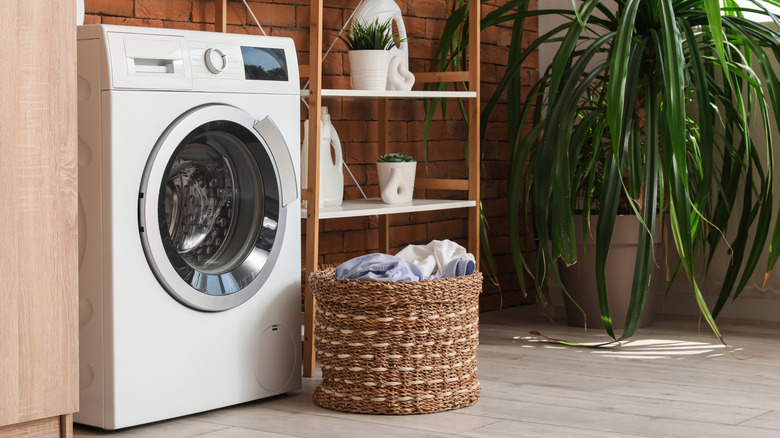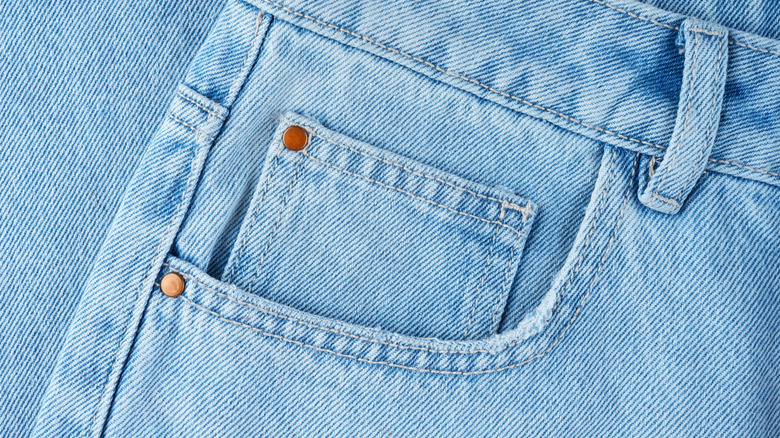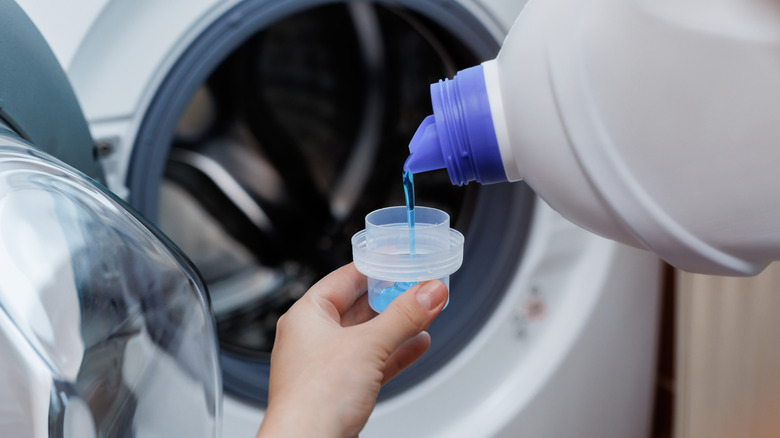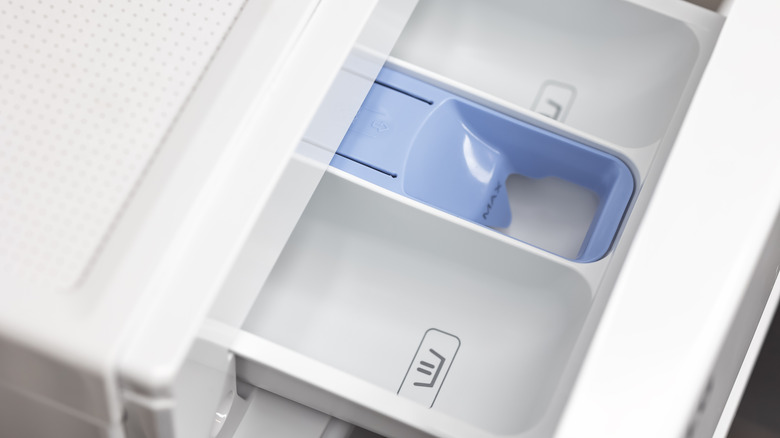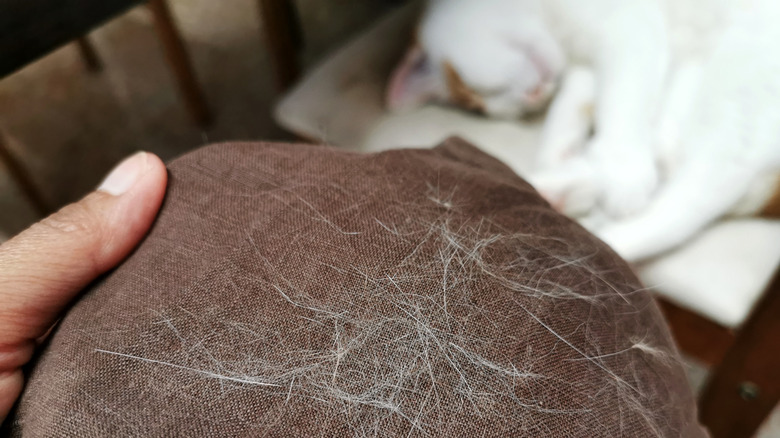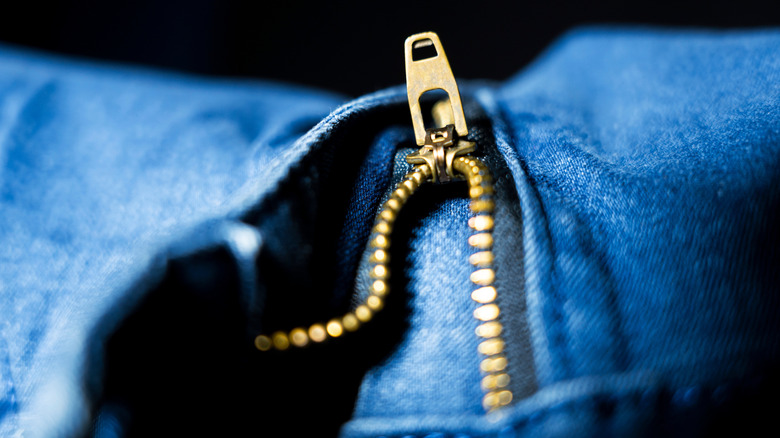12 Habits That Are Destroying Your Washing Machine
We may receive a commission on purchases made from links.
On average, families in the United States do 300 to 390 loads of laundry a year. In order to make this activity as stress-free as possible, many people develop laundry routines to get their clothes clean as quickly and efficiently as possible. What some people don't realize, however, is that some of their laundry habits could actually be harming their washing machine. Whether you like to use lots of detergent or tend to forget things in your pockets, these seemingly harmless things can become big problems for your washing machine if done repeatedly.
Over time, some of your laundry habits can be the cause of costly repairs and could even leave you having to shell out money for a whole new washing machine. Fortunately, knowing what not to do (and why) can help keep your appliance and your clothes in tip-top shape. Here are 12 habits that are destroying your washing machine.
Using too much fabric softener can cause clogs and buildup
Fabric softener is a popular additive to many people's laundry routines. It is designed to coat your clothing and soften the fibers. While this may seem harmless, using too much fabric softener can have negative consequences for your washing machine. Many fabric softeners are made from tallow dimethyl ammonium chloride, a chemical that comes from animal fat. When fabric softener is over used, it can eventually cause residue to build up which can lead to mold growing in your washing machine.
So, what can you do if you want your clothes to feel soft, but not at the expense of your washing machine? First and foremost, you should read your laundry machine's manual to ensure that you only use the recommended amount of fabric softener. However, if you want to try something different altogether, laundry experts recommend wool dryer balls as a good alternative. These balls can be added to the dryer with your wet clothes and will help absorb moisture and static, and leave your clothes feeling softer. You can also try adding a half cup of white vinegar to your rinse cycle. Vinegar breaks down excess detergent and mineral buildup to leave your clothes feeling softer, but be warned that the acidity of vinegar can also damage the rubber pats of your washing machine, so it may not be worth it.
Leaving the door closed between washes can lead to mold and mildew growth
If you're in the habit of closing your washing machine's door after each load, you might want to think again. While this simple act may seem harmless, it's actually not good for your washing machine. When the door is constantly closed, moisture remains inside the machine and can cause mold and mildew to grow. Additionally, long-term exposure to moisture can cause your washing machine's components to rust and/or corrode, which can ultimately impact your appliance's lifespan.
To avoid this problem, remember to leave your washing machine's door open between washes (whether you have a front or top-load washer). Not only will this benefit your machine, but it'll also benefit your nose. On top of potentially damaging your washing machine, constantly leaving the door closed can also lead to bad smells coming from the drum.
Not emptying pockets of objects that can damage the machine
Forgetting to empty pockets before doing a load of laundry may not seem like a big deal, but the truth is that it can lead to much worse outcomes than soggy tissues, bent hair clips, and damaged lip balms. When items left in pockets go through the wash cycle, they can become loose and scratch your washing machine's drum. These items can also potentially get stuck in the machine's components, leading to costly repairs. In some cases, loose items can even damage the glass door on front-loading washers.
Before each load of laundry, it's important to check the pockets on all your clothing to ensure nothing has been left behind. You may even want to wash your clothes with the pockets inside out so you'll know that they're completely empty. Washing machine manufacturer Samsung also recommends checking and cleaning your machine's door seal on a regular basis, in case any small objects have accidentally gotten stuck.
Neglecting to clean your washing machine can affect its performance
Since washing machines are constantly being filled with soap and water, some people may be under the impression that the machine itself doesn't need to be cleaned. However, that couldn't be any further from the truth. In addition to mold and mildew buildup, a dirty washing machine can use more energy, because you may have to wash your clothes longer or more times to get them clean. In some cases, not cleaning your washer can also cause sensors to malfunction over time because accumulated dirt, debris, and residue can lead to interference.
Washing machine manufacturers suggest cleaning your machine about once a month. Before cleaning your washing machine, it's important to read the manual to understand the best way to clean your specific unit. Some machines have a cleaning or sanitizing cycle, while others do not. Some brands, such as Samsung, note that no cleaning agents should be used when the machine is set to a Drum Clean cycle. Whirlpool, however, suggests using Affresh Washing Machine Cleaner tablets or another washing machine cleaner — so it all depends on your specific machine.
Using too much detergent can clog hoses and result in excessive suds
It can be easy to think that adding a lot of detergent will make your laundry cleaner. Unfortunately, though, too much detergent can actually do more harm than good. Loading up the washer with detergent can clog hoses, which can eventually lead to drainage issues. In addition to potentially damaging the machine, poor draining can cause moisture to build up and mold and mildew to grow. On top of that, adding too much detergent results in excessive suds during your wash cycle. This can result in the machine having to run another rinse cycle. Not only does this waste water, but it also puts more wear and tear on your washer.
In general, experts recommend using just 2 tablespoons of detergent per load. It's also a good idea to use high-efficiency detergent (even if you don't have a high-efficiency washing machine), as this detergent was specifically designed to create fewer suds and to get clothes cleaner using less water. Keep in mind, though, that if you don't have a high-efficiency washing machine, you'll have to use a little more high-efficiency laundry detergent.
Adding too many clothes to a load puts too much strain on your machine
Let's face it, when you have a bunch of dirty clothes, it can be tempting to throw them all into one big load. But while this may seem like a quick and easy shortcut, it can have some serious consequences for your washing machine. When your washing machine is overloaded, it will also become overworked. This will strain the drive components and put extra wear and tear on your machine. Plus, overloading your washer means it won't be able to clean your clothes effectively.
While most washing machines can handle bulky items (and may even have a "bulky" setting), you still don't want to pack the drum completely. According to experts, once you've loaded your clothes, you should have room to stick one hand in the drum and move it around. If you've accidentally overloaded your washer, the door may be hard to close, you hear excessive vibrating during the wash, or the drum might not spin easily. In some cases, your machine may even give you an error code.
Letting wet clothes sit in the machine overnight can cause mold and mildew
If you've left a load of wet clothes in the washer overnight, you certainly aren't alone. Although accidentally doing this every once in a while isn't the end of the world, it's not something you want to make a habit of. Wet clothes create the perfect environment for mildew and mold to grow. This can be especially problematic for front-loading machines, as mildew can build up in the rubber seals. On top of the potential damage to your washer, leaving wet clothes in the machine for long periods of time can result in some pretty nasty smells and require you to rewash your items.
If possible, try not to let wet clothes sit in the washer for more than 8 to 12 hours. If this happens, do a quick sniff test on your clothes. If they smell a little off, you may want to rewash them before drying. If they still smell fresh, you can gently shake them out and put them in the dryer as usual.
Not cleaning the detergent drawer can lead to clogs in the dispenser
Your washing machine's drum isn't the only area that needs to be cleaned on a regular basis. The detergent drawer needs a little TLC, too. Over time, detergent can build up in the drawer and eventually clog the jets in the dispenser. This can lead to the detergent not being released properly during the wash cycle and could ultimately require a professional repair or a new detergent drawer.
Whirlpool suggests cleaning the detergent drawer every two to four weeks. If you have hard water or your dispenser drawer looks dirty, you may want to clean it more frequently. To start the cleaning process, remove the drawer from the machine and wash it using warm water and mild soap. You can use a soft brush to get rid of stubborn residue and/or debris. Once you've finished cleaning, simply slide the drawer back in its place. Please note that this only applies to front-loading washing machines.
Not leveling your washing machine puts extra stress on its components
If your washing machine vibrates and shakes excessively while washing, there's a chance that it needs to be leveled. While all the moving and shaking may seem like nothing more than a nuisance, it can actually damage your washing machine. When a washer remains unbalanced, it can put extra stress on the machine's components, which can lead to costly repairs and even cut down on your washer's lifespan.
To ensure that your washing machine is level, simply place a level on top of the machine to identify which side is imbalanced. Next, you'll need to adjust the legs to ensure all four of them are even so that the washer rests squarely on the floor. Depending on the type of washer you have, you may need a wrench to adjust the legs. Use a level to re-check the machine to ensure that it is properly balanced. Since this process will require the washer to be slightly lifted and tilted, it's probably a good idea to have someone help with the process.
Not removing pet hair from clothes before washing can cause clogs in the drain pump
It may be your washing machine's job to clean your clothes, but that doesn't mean you can throw things in there completely covered in dog hair. When pet hair gets wet, it starts to clump together, which can cause problems for your washing machine. Clumps of wet pet hair can get stuck to the drain pumps and cause clogs that lead to drainage issues. Not being able to drain properly puts stress on your washer and can impact its performance.
If you have a pet that sheds, it's important to remove its hair from your clothing and blankets before putting them in the wash. Using a lint roller is one of the most straightforward ways to remove pet hair from clothes. However, if you have a lot of things that are covered in pet hair, you may prefer something a little less manual. Putting your clothes in the dryer on a no-heat setting for about 10 minutes can help loosen up and remove pet hair from fabric. Using dryer sheets after washing is also a good way to prevent pet hair from sticking to your clothing, because these sheets remove static.
Washing clothes with the zipper down creates more opportunities for scratches on the drum
Emptying your pockets isn't the only thing you should do before putting your clothes in the washing machine. It's also a good idea to make sure that all of your zippers are up. When zippers are left down during the wash cycle, they scratch the inside of your washing machine or damage the glass on the door, which can ultimately lead to leaks. Over time, repeated damage could mean that you'll need to replace your washing machine.
Leaving zippers down isn't only bad for your washing machine, it can also damage other items in your load, because the zipper can catch on to fabric when your clothes are spinning around in the wash. In addition to making sure zippers are up, it's also a good idea to button shirts and/or jackets, as buttons also have the potential to damage your washing machine.
Washing rugs and mats with rubber backings can cause clogs, imbalances, and motor strain
If you've been throwing bath and/or kitchen mats into your washing machine without a second thought, that might change after reading this. Mats with rubber backings can cause serious damage to your washing machine. When these mats are washed repeatedly, the rubber can start to break into small pieces. These pieces can cause clogs in the washing machine's drain hose. That isn't the only thing you have to be mindful of, though. Rubber-backed mats can also become very heavy when wet, which forces your washing machine to work harder. This additional stress can impact the machine's lifespan.
Instead of just putting your bath mats into the washing machine, you can try alternative cleaning methods, such as vacuuming or hand-washing. If you need to wash your rubber-backed mat in your washing machine, it's important to read the label to ensure that you're washing it correctly and lowering your risk of causing any damage.


